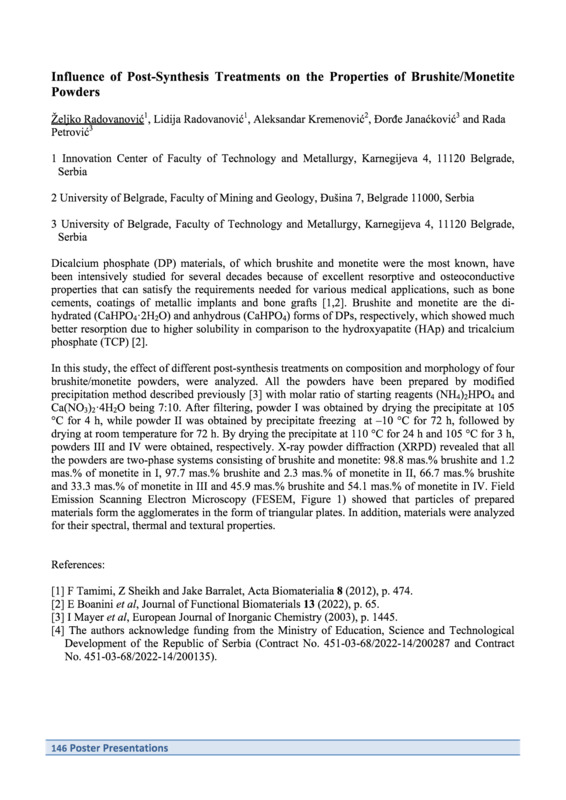Influence of Post-Synthesis Treatments on the Properties of Brushite/Monetite Powders
Објеката
- Тип
- Саопштење са скупа штампано у изводу
- Верзија рада
- објављена
- Језик
- енглески
- Креатор
- Željko Radovanović, Lidija Radovanović, Aleksandar Kremenović, Đorđe Janaćković, Rada Petrović
- Извор
- Second International Conference on Electron Microscopy of Nanostructures ELMINA 2022, August 22nd–26th, 2022, Belgrade, Serbia
- Уредник
- Velimir R. Radmilović, Vuk V. Radmilović
- Издавач
- Serbian Academy of Sciences and Arts Knez Mihailova 35, 11000 Belgrade, Serbia
- Датум издавања
- 2022
- Сажетак
-
Dicalcium phosphate (DP) materials, of which brushite and monetite were the most known, have been intensively studied for several decades because of excellent resorptive and osteoconductive properties that can satisfy the requirements needed for various medical applications, such as bone cements, coatings of metallic implants and bone grafts [1,2]. Brushite and monetite are the dihydrated (CaHPO4·2H2O) and anhydrous (CaHPO4) forms of DPs, respectively, which showed much better resorption due to higher solubility in comparison to the hydroxyapatite (HAp) and tricalcium phosphate (TCP) [2].
In this study, the effect of different post-synthesis treatments on composition and morphology of four brushite/monetite powders, were analyzed. All the powders have been prepared by modified precipitation method described previously [3] with molar ratio of starting reagents (NH4)2HPO4 and Ca(NO3)2·4H2O being 7:10. After filtering, powder I was obtained by drying the precipitate at 105 °C for 4 h, while powder II was obtained by precipitate freezing at ‒10 °C for 72 h, followed by drying at room temperature for 72 h. By drying the precipitate at 110 °C for 24 h and 105 °C for 3 h, powders III and IV were obtained, respectively. X-ray powder diffraction (XRPD) revealed that all the powders are two-phase systems consisting of brushite and monetite: 98.8 mas.% brushite and 1.2 mas.% of monetite in I, 97.7 mas.% brushite and 2.3 mas.% of monetite in II, 66.7 mas.% brushite and 33.3 mas.% of monetite in III and 45.9 mas.% brushite and 54.1 mas.% of monetite in IV. Field Emission Scanning Electron Microscopy (FESEM, Figure 1) showed that particles of prepared materials form the agglomerates in the form of triangular plates. In addition, materials were analyzed for their spectral, thermal and textural properties. - почетак странице
- 146
- крај странице
- 147
- isbn
- 978-86-7025-943-0
- Шира категорија рада
- М30
- Ужа категорија рада
- М34
- Права
- Отворени приступ
- Лиценца
- Creative Commons – CC0 Public Domain
- Формат
- Медија
 apstrakt.pdf
apstrakt.pdf
Željko Radovanović, Lidija Radovanović, Aleksandar Kremenović, Đorđe Janaćković, Rada Petrović. "Influence of Post-Synthesis Treatments on the Properties of Brushite/Monetite Powders " in Second International Conference on Electron Microscopy of Nanostructures ELMINA 2022, August 22nd–26th, 2022, Belgrade, Serbia, Serbian Academy of Sciences and Arts Knez Mihailova 35, 11000 Belgrade, Serbia (2022) М34
This item was submitted on 8. децембар 2022. by [anonymous user] using the form “Рад у зборнику радова” on the site “Радови”: http://gabp-dl.rgf.rs/s/repo
Click here to view the collected data.